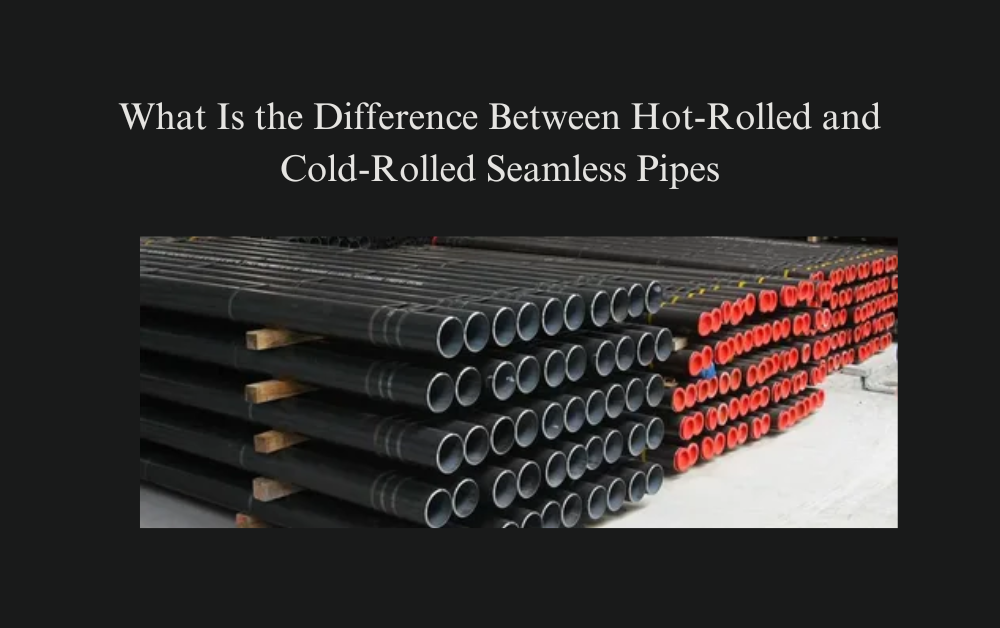When it comes to seamless pipes, understanding the difference between hot-rolled and cold-rolled options is essential for selecting the right one for your project. Seamless pipes are a popular choice in various industries due to their strength, durability, and ability to handle high pressure. However, how they are made—whether hot-rolled or cold-rolled—affects their performance, cost, and applications.
In this blog, we’ll take a deep look at both types of seamless pipes, explaining the manufacturing process, benefits, and specific uses of each. This will help you better understand which type is suitable for your needs.
What Are Seamless Pipes?
Before we dive into the difference between hot-rolled and cold-rolled seamless pipes, let’s first clarify what seamless pipes are.
What Does “Seamless” Mean in Pipes?
Seamless pipes are pipes without any welded seams or joints. They are manufactured from a solid piece of material, typically steel, which is heated and molded into a pipe shape. This makes seamless pipes stronger and more reliable, especially when used in high-pressure environments. Unlike welded pipes, which have a seam where two pieces are joined together, seamless pipes are less prone to leaks and weak points.
Why Are Seamless Pipes Important?
Seamless pipes are used in a variety of industries, including oil and gas, power generation, automotive, and construction. Their strength and durability make them ideal for transporting liquids and gases under high pressure, as well as for other heavy-duty applications. The absence of seams means that there are fewer risks of failure or corrosion over time.
What Is Hot-Rolled Seamless Pipe?
Let’s start by understanding what hot-rolled seamless pipes are and how they are made.
How Are Hot-Rolled Seamless Pipes Manufactured?
Hot-rolled seamless pipes are made by heating a solid piece of steel (called a billet) to a very high temperature, usually over 1,000 degrees Fahrenheit (540 degrees Celsius). Once the billet is heated, it is pushed or pulled through a series of rollers to shape it into a hollow tube. This is done while the steel is still hot, making it easier to mold and shape.
The Rolling Process in Hot-Rolled Seamless Pipes
During the rolling process, the hot steel passes through multiple rollers that gradually reduce its thickness and shape it into a pipe. The steel is continuously rolled until it reaches the desired size and thickness. Because the steel is hot, it remains flexible and easy to work with, allowing for the production of larger-diameter pipes.
Key Features of Hot-Rolled Seamless Pipes
- Larger pipe sizes: Hot-rolled seamless pipes are typically used for larger diameter pipes.
- Cost-effective: The manufacturing process is less complex, making hot-rolled pipes more affordable.
- Surface finish: Hot-rolled pipes usually have a rougher surface and less precision in terms of size.
- High-temperature applications: Hot-rolled pipes are better suited for applications that involve high heat.
What Is Cold-Rolled Seamless Pipe?
Now, let’s look at cold-rolled seamless pipes and how they differ from their hot-rolled counterparts.
How Are Cold-Rolled Seamless Pipes Manufactured?
Cold-rolled seamless pipes are made by taking a hot-rolled pipe and cooling it down before rolling it again at room temperature. This second rolling process is done using high-pressure rollers, which improve the pipe’s precision and finish. Since the material is not heated during this process, it is referred to as “cold rolling.”
The Rolling Process in Cold-Rolled Seamless Pipes
The cold-rolling process results in pipes that have tighter tolerances and smoother surfaces. After the hot-rolled pipe has been cooled, it is passed through a series of rollers that reduce its size and improve its overall quality. This process increases the pipe’s strength and gives it a more refined appearance.
Key Features of Cold-Rolled Seamless Pipes
- Smaller pipe sizes: Cold-rolled pipes are typically made in smaller diameters due to the higher precision required.
- Higher strength: Cold rolling improves the strength of the pipe.
- Smooth finish: Cold-rolled pipes have a smoother surface and more accurate dimensions.
- Higher cost: The cold-rolling process is more complex, making these pipes more expensive.
- Better for precision applications: These pipes are ideal for applications that require exact measurements and a high-quality surface finish.
What Are the Main Differences Between Hot-Rolled and Cold-Rolled Seamless Pipes?
Now that we understand how both types of pipes are made, let’s explore the key differences between hot-rolled and cold-rolled seamless pipes.
Difference in Manufacturing Process
- Hot-Rolled Seamless Pipes: These are made by heating steel to a high temperature and rolling it into a pipe while it’s still hot. This process is faster and cheaper.
- Cold-Rolled Seamless Pipes: These are made by taking a hot-rolled pipe, cooling it, and rolling it again at room temperature. This extra step gives the pipe a more polished finish and improved strength but increases the cost.
Difference in Strength and Durability
- Hot-Rolled Pipes: While strong, hot-rolled pipes are generally less durable than cold-rolled ones due to the nature of the manufacturing process. However, they are still highly reliable for many industrial applications.
- Cold-Rolled Pipes: Cold-rolled pipes are stronger and more durable due to the additional rolling process, which tightens the pipe’s structure and increases its tensile strength.
Difference in Surface Finish
- Hot-Rolled Pipes: These pipes have a rougher surface finish and less precise dimensions. This is not usually a problem for applications where the pipe’s appearance or exact size is not critical.
- Cold-Rolled Pipes: Cold-rolled pipes have a smooth surface and more precise dimensions, making them ideal for applications where appearance and precision are important.
Difference in Cost
- Hot-Rolled Pipes: Because the manufacturing process is simpler, hot-rolled pipes are typically more affordable. They are a good choice when budget is a concern.
- Cold-Rolled Pipes: The cold-rolling process adds to the cost, making cold-rolled pipes more expensive. However, the improved strength and finish may be worth the extra investment for certain applications.
Difference in Applications
- Hot-Rolled Pipes: These are used in applications that do not require precise dimensions or a smooth surface. Common uses include structural components, pipes for transporting fluids, and general construction.
- Cold-Rolled Pipes: These pipes are often used in situations where a high-quality finish and exact measurements are needed, such as in the automotive industry, aerospace, and precision machinery.
Which Type of Seamless Pipe Should You Choose?
Choosing between hot-rolled and cold-rolled seamless pipes depends on your specific needs, budget, and the requirements of your project.
When to Choose Hot-Rolled Seamless Pipes
- For larger pipe sizes: If you need pipes with a larger diameter, hot-rolled seamless pipes are the way to go.
- For high-temperature environments: Hot-rolled pipes can handle heat better, making them a good choice for high-temperature applications.
- For cost-effective solutions: If budget is a concern and you don’t need a smooth finish or precise dimensions, hot-rolled pipes are a more affordable option.
When to Choose Cold-Rolled Seamless Pipes
- For precision work: If your project requires exact measurements and a high-quality surface, cold-rolled seamless pipes are the better option.
- For smaller pipe sizes: Cold-rolled pipes are typically made in smaller diameters, which is perfect for precision applications.
- For stronger, more durable pipes: The cold-rolling process strengthens the pipe, making it ideal for applications that require extra durability.
Conclusion
The main difference between hot-rolled and cold-rolled seamless pipes lies in the manufacturing process. Hot-rolled pipes are made by heating the material and rolling it while it’s still hot, resulting in a rougher finish and lower cost. Cold-rolled pipes, on the other hand, undergo an additional rolling process at room temperature, giving them a smoother surface, higher strength, and greater precision.
When choosing between the two, consider the specific needs of your project. If you need larger, cost-effective pipes that can handle high temperatures, hot-rolled pipes may be the right choice. If you require precision, strength, and a smoother finish, cold-rolled pipes are the better option.
Understanding the differences between these two types of seamless pipes will help you make an informed decision and ensure that your project runs smoothly.
For more insightful articles related to this topic, feel free to visit coeruniversity.com


 войдут На Официальный Сайт 1хбет Прямо теперь По Рабочей Ссылке
войдут На Официальный Сайт 1хбет Прямо теперь По Рабочей Ссылке

